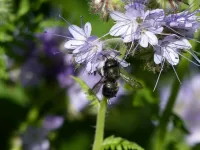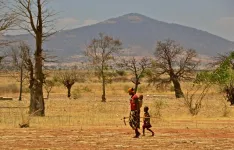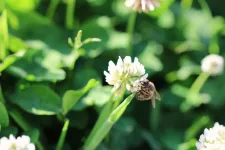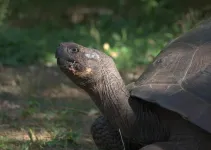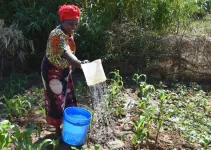Diffractive networks light the way for optical image classification
2021-01-14
(Press-News.org) Recently there has been a reemergence of interest in optical computing platforms for artificial intelligence-related applications. Optics/photonics is ideally suited for realizing neural network models because of the high speed, large bandwidth and high interconnectivity of optical information processing. Introduced by UCLA researchers, Diffractive Deep Neural Networks (D2NNs) constitute such an optical computing framework, comprising successive transmissive and/or reflective diffractive surfaces that can process input information through light-matter interaction. These surfaces are designed using standard deep learning techniques in a computer, which are then fabricated and assembled to build a physical optical network. Through experiments performed at terahertz wavelengths, the capability of D2NNs in classifying objects all-optically was demonstrated. In addition to object classification, the success of D2NNs in performing miscellaneous optical design and computation tasks, including e.g., spectral filtering, spectral information encoding, and optical pulse shaping have also been demonstrated.
In their latest paper published in Light: Science & Applications, UCLA team reports a leapfrog advance in D2NN-based image classification accuracy through ensemble learning. The key ingredient behind the success of their approach can be intuitively understood through the experiment of Sir Francis Galton (1822-1911), an English philosopher and statistician, who, while visiting a livestock fair, asked the participants to guess the weight of an ox. None of the hundreds of participants succeeded in guessing the weight. But to his astonishment, Galton found that the median of all the guesses came quite close - 1207 pounds, and was accurate within 1% of the true weight of 1198 pounds. This experiment reveals the power of combining many predictions in order to obtain a much more accurate prediction. Ensemble learning manifests this idea in machine learning, where an improved predictive performance is attained by combining multiple models.
In their scheme, UCLA researchers reported an ensemble formed by multiple D2NNs operating in parallel, each of which is individually trained and diversified by optically filtering their inputs using a variety of filters. 1252 D2NNs, uniquely designed in this manner, formed the initial pool of networks, which was then pruned using an iterative pruning algorithm, so that the resulting physical ensemble is not prohibitively large. The final prediction comes from a weighted average of the decisions from all the constituent D2NNs in an ensemble. The researchers evaluated the performance of the resulting D2NN ensembles on CIFAR-10 image dataset, which contains 60,000 natural images categorized in 10 classes and is an extensively used dataset for benchmarking various machine learning algorithms. Simulations of their designed ensemble systems revealed that diffractive optical networks can significantly benefit from the 'wisdom of the crowd'. For example, with an ensemble of 14 individually trained D2NNs, the researchers achieved 61.21% blind testing accuracy on CIFAR-10 dataset, which is ~16% higher than the average accuracy of the individual constituent D2NNs.
This research is led by Professor Aydogan Ozcan from the Electrical and Computer Engineering Department at UCLA, USA. This significantly improved inference and generalization performance achieved by D2NN ensembles marks a major advancement in closing the gap between optical neural networks and their digital counterparts. Together with the advances in the fabrication and assembly of nanoscale optical systems, the presented framework bears the promise for miniaturized, ultrafast machine learning solutions for a variety of applications, for example, all-optical object classification, diffraction-based optical computing hardware, and computational imaging tasks.
INFORMATION:
[Attachments] See images for this press release:
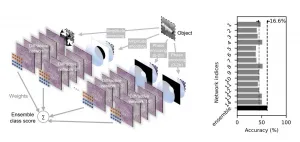
ELSE PRESS RELEASES FROM THIS DATE:
2021-01-14
CORVALLIS, Ore. - Researchers at Oregon State University have found that the blue orchard bee, an important native pollinator, produces female offspring at higher rates in the aftermath of wildfire in forests.
The more severe the fire had been, the greater percentage of females - more than 10% greater in the most badly burned areas relative to areas that burned the least severely.
"This is one of the first studies that has looked at how forest fire severity influences bee demography," said Jim Rivers, an animal ecologist with the OSU College of Forestry. "Sex ratio varied under different fire conditions but the number of young produced did not, which indicates bees ...
2021-01-14
A first-of-its-kind, international study of 107,000 children finds that higher temperatures are an equal or even greater contributor to child malnutrition and low quality diets than the traditional culprits of poverty, inadequate sanitation, and poor education.
The 19-nation study is the largest investigation of the relationship between our changing climate and children's diet diversity to date. It is believed to be the first study across multiple nations and continents of how both higher temperatures and rainfall--two key results of climate change--have impacted children's diet diversity.
"Certainly, future climate changes have been predicted to affect malnutrition, but it surprised ...
2021-01-14
DALLAS, Jan. 14, 2021 -- The longer the time between when heart attack symptoms start and a patient has an artery-clearing percutaneous coronary intervention (PCI), the more damage to the heart muscle, according to new research published today in Circulation: Cardiovascular Interventions, an American Heart Association journal.
A heart attack happens about every 40 seconds in the U.S., and the most common heart attack is caused by a complete blockage in a coronary artery, called ST-elevation myocardial infarction (STEMI). STEMI patients are most often treated with PCI, also known as angioplasty with stent, in which a catheter with a deflated balloon is inserted into the narrowed heart artery. Subsequently, the balloon is inflated, which clears the obstruction and restores ...
2021-01-14
DALLAS, Jan. 14, 2021 -- Adults who smoke or who are genetically predisposed to smoking behaviors are more likely to experience a serious type of stroke called subarachnoid hemorrhage (SAH), according to new research published today in Stroke, a journal of the American Stroke Association, a division of the American Heart Association. The results of this study provide important evidence that there is a causal link between smoking and the risk of SAH.
SAH is a type of stroke that occurs when a blood vessel on the surface of the brain ruptures and bleeds into the space between the brain and the skull. It mainly affects middle-aged adults and has high rates of complications ...
2021-01-14
MEDFORD/SOMERVILLE (January 14, 2021) - A team of researchers led by engineers at Tufts University's School of Engineering and Stanford University's Program on Water, Health and Development have developed a novel and inexpensive chlorine dispensing device that can improve the safety of drinking water in regions of the world that lack financial resources and adequate infrastructure. With no moving parts, no need for electricity, and little need for maintenance, the device releases measured quantities of chlorine into the water just before it exits the tap. It provides a quick and ...
2021-01-14
There is a growing consensus among scientists as well as national and local governments representing hundreds of millions of people, that humanity faces a climate crisis that demands a crisis response. New research from the University of California San Diego explores one possible mode of response: a massively funded program to deploy direct air capture (DAC) systems that remove CO2 directly from the ambient air and sequester it safely underground.
The findings reveal such a program could reverse the rise in global temperature well before 2100, but only with immediate and sustained investments from governments and firms to scale up the new technology.
Despite the enormous undertaking explored in the study, the research ...
2021-01-14
Honeybee historians might seem like a flight of fancy but these tiny pollinators have been helping researchers from the National Botanic Garden of Wales track how the UK's fields, hedgerows, wild spaces and gardens have changed since the 1950s.Using cutting-edge DNA barcoding techniques, scientists at the Botanic Garden identified which plants modern-day honeybees visited most often by looking at the pollen grains trapped within honey.
They compared this to a 1952 survey of honey plants where a microscope had been used to painstakingly identify pollen grains in honey sent from hives across the country. The differences were clear. White clover had been the most important plant for honeybees but, with fewer pastures today and increased use of herbicides and inorganic ...
2021-01-14
New research has unlocked the mystery of how the Galápagos Islands, a rocky, volcanic outcrop, with only modest rainfall and vegetation, is able to sustain its unique wildlife habitats.
The Galápagos archipelago, rising from the eastern equatorial Pacific Ocean some 900 kilometres off the South American mainland, is an iconic and globally significant biological hotspot. The islands are renowned for their unique wealth of endemic species, which inspired Charles Darwin's theory of evolution and today underpins one of the largest UNESCO World Heritage Sites and Marine Reserves on Earth.
Scientists have known ...
2021-01-14
Water isn't just crucial for life, it's fundamental to increasing opportunities for women and girls in rural areas across the globe. A new Stanford study reveals how bringing piped water closer to remote households in Zambia dramatically improves the lives of women and girls, while also improving economic opportunities, food security and well-being for entire households. The research, recently published in Social Science & Medicine, could spur governments and NGOs to more carefully evaluate the costs and benefits of piped water as an alternative to less accessible communal water sources.
"Switching from the village borehole to piped supply saved almost 200 hours of fetching time per year for a typical household," said study senior ...
2021-01-14
A new paper in Q Open finds that the availability of fast food restaurants on the route between children's houses and their schools does not affect children's weight.
Reducing the rate of childhood obesity is a top public health priority in the United States where obesity rates are 18.4% for those ages 6-11 and 20.6% for those ages 12-19. Childhood obesity is a documented risk-factor for negative physical and mental health outcomes. Obese children are also more likely to become obese adults and suffer associated health problems.
Researchers have proposed that the accessibility ...
LAST 30 PRESS RELEASES:
[Press-News.org] Diffractive networks light the way for optical image classification

